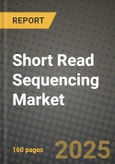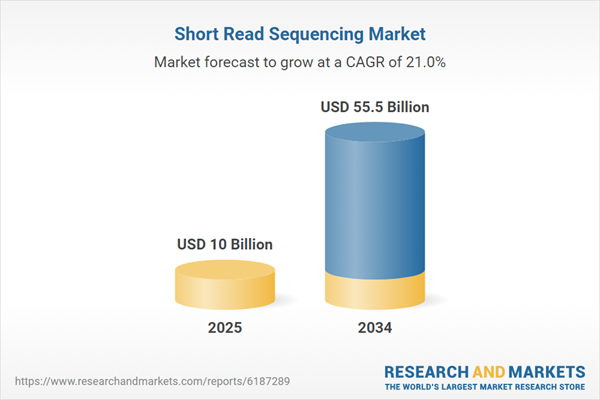The short read sequencing market plays a vital role in modern genomics, enabling the high-throughput analysis of DNA and RNA at an affordable cost with high accuracy. Short read sequencing, typically generating reads of 50 to 300 base pairs, is widely used in applications such as whole genome sequencing, targeted sequencing, exome sequencing, and transcriptomics. It is particularly effective for detecting single nucleotide polymorphisms (SNPs), small insertions and deletions (indels), and gene expression patterns. Leading platforms from companies like Illumina dominate this market, supported by robust workflows and extensive bioinformatics tools. The adoption of short read sequencing has expanded across research institutions, clinical diagnostics, agriculture, and pharmaceutical sectors. As precision medicine and personalized healthcare continue to advance, the demand for rapid, cost-efficient, and scalable genomic technologies is accelerating. While competition from long read technologies is emerging, short read sequencing remains the backbone of large-scale genomic studies due to its maturity, cost-effectiveness, and analytical consistency.
The short read sequencing market experienced steady growth as healthcare systems and research institutions prioritized genomic analysis for disease diagnostics, population genetics, and oncology. Advancements in chemistry and library preparation protocols enhanced sequencing speed and sample throughput, enabling faster turnarounds for clinical applications. Bioinformatics software also improved, offering more streamlined variant calling and data visualization tools tailored for short read outputs. Cancer diagnostics saw a surge in demand for targeted gene panels powered by short read platforms, particularly for detecting actionable mutations in tumor biopsies and liquid samples. Research in infectious disease genomics expanded globally, leveraging short read sequencing to track pathogens, study antimicrobial resistance, and monitor outbreaks in real time. Strategic partnerships between academic centers and sequencing providers supported large-scale initiatives like biobank genome projects and pharmacogenomics studies. The clinical utility of short read sequencing, especially in non-invasive prenatal testing (NIPT) and inherited disease screening, continued to validate its broad applicability and future market potential.
The short read sequencing market is expected to further diversify and deepen its integration into clinical and translational research. Advancements in multi-omics integration - combining genomics, transcriptomics, and epigenomics - will increasingly rely on short read platforms for accurate base-level resolution. The development of compact, benchtop sequencers and low-cost library kits will expand access in emerging markets and decentralized healthcare settings. AI-powered bioinformatics platforms will enhance interpretation speed, reduce error rates, and support clinical decision-making in precision oncology and rare disease diagnostics. As regulatory frameworks evolve, more diagnostic assays based on short read sequencing will achieve formal approvals, boosting adoption in hospital labs and point-of-care environments. At the same time, new hybrid sequencing approaches will emerge, blending short and long read data to overcome technical limitations and deliver more comprehensive insights. With continued innovation and cross-sector collaboration, short read sequencing will remain foundational to the global genomics ecosystem.
Key Insights: Short Read Sequencing Market
- Rising demand for targeted gene panels and liquid biopsy diagnostics is expanding the clinical utility of short read sequencing in oncology and inherited disease detection.
- Integration of AI and machine learning tools into sequencing workflows is accelerating data analysis, improving variant interpretation, and reducing turnaround time.
- Growing use of multi-omics approaches is increasing reliance on short read sequencing for transcriptomics and epigenomics alongside DNA analysis.
- Benchtop sequencers with simplified workflows are gaining traction in decentralized labs and emerging markets seeking cost-effective genomic solutions.
- Collaborations between public health agencies and genomic firms are driving large-scale population studies using short read platforms to inform disease prevention and drug development.
- Increased prevalence of genetic disorders and cancer is fueling demand for precise, scalable sequencing solutions in both research and diagnostics.
- Cost reductions and technological improvements are making short read sequencing more accessible across a wider range of clinical and research settings.
- Government and private funding in genomics and personalized medicine initiatives are supporting market expansion and infrastructure development.
- Advancements in bioinformatics tools are enabling more efficient interpretation and clinical reporting from short read data, enhancing usability for end-users.
- Limited ability of short read sequencing to resolve complex genomic regions, structural variants, and long-range haplotypes presents analytical gaps, prompting the need for hybrid or long read technologies in certain high-resolution applications.
Short Read Sequencing Market Segmentation
By Product
- Instruments
- Consumables
- Services.
By Technology
- Next-Generation Sequencing
- Sanger Sequencing.
By Workflow
- Pre-Sequencing
- Sequencing
- Data Analysis.
By Application
- Clinical Investigation
- Oncology
- Reproductive Health
- Consumer Genomics
- Agri genomics and Forensics
- HLA Typing/ Immune System Monitoring.
By End Users
- Academic Research
- Hospitals and Clinics
- Clinical Research
- Pharmaceutical and Biotechnology Companies.
Key Companies Analysed
- F. Hoffmann-La Roche AG
- Thermo Fisher Scientific Inc.
- GE HealthCare Technologies Inc.
- Cytiva Lifesciences
- Eurofins Scientific SE
- Agilent Technologies Inc.
- Beckman Coulter Inc.
- Illumina Inc.
- QIAGEN N.V.
- PerkinElmer Inc.
- BGI Genomics Co Ltd
- MGI Tech Co. Ltd.
- GenScript Biotech Corporation.
- 10x Genomics Inc.
- Novogene Co. Ltd
- Oxford Nanopore Technologies Ltd.
- Pacific Biosciences of California Inc.
- Macrogen Inc.
- Genewiz Inc.
- Zymo Research Corporation
- GenapSys Inc.
- Fasteris SA
- GnuBIO Inc.
- Paragon Genomics Inc.
- Nabsys Inc.
- GATC Biotech AG
- Halcyon Molecular Inc.
Short Read Sequencing Market Analytics
The report employs rigorous tools, including Porter’s Five Forces, value chain mapping, and scenario-based modeling, to assess supply-demand dynamics. Cross-sector influences from parent, derived, and substitute markets are evaluated to identify risks and opportunities. Trade and pricing analytics provide an up-to-date view of international flows, including leading exporters, importers, and regional price trends.
Macroeconomic indicators, policy frameworks such as carbon pricing and energy security strategies, and evolving consumer behavior are considered in forecasting scenarios. Recent deal flows, partnerships, and technology innovations are incorporated to assess their impact on future market performance.Short Read Sequencing Market Competitive Intelligence
The competitive landscape is mapped through proprietary frameworks, profiling leading companies with details on business models, product portfolios, financial performance, and strategic initiatives. Key developments such as mergers & acquisitions, technology collaborations, investment inflows, and regional expansions are analyzed for their competitive impact. The report also identifies emerging players and innovative startups contributing to market disruption.
Regional insights highlight the most promising investment destinations, regulatory landscapes, and evolving partnerships across energy and industrial corridors.Countries Covered
- North America - Short Read Sequencing market data and outlook to 2034
- United States
- Canada
- Mexico
- Europe - Short Read Sequencing market data and outlook to 2034
- Germany
- United Kingdom
- France
- Italy
- Spain
- BeNeLux
- Russia
- Sweden
- Asia-Pacific - Short Read Sequencing market data and outlook to 2034
- China
- Japan
- India
- South Korea
- Australia
- Indonesia
- Malaysia
- Vietnam
- Middle East and Africa - Short Read Sequencing market data and outlook to 2034
- Saudi Arabia
- South Africa
- Iran
- UAE
- Egypt
- South and Central America - Short Read Sequencing market data and outlook to 2034
- Brazil
- Argentina
- Chile
- Peru
Research Methodology
This study combines primary inputs from industry experts across the Short Read Sequencing value chain with secondary data from associations, government publications, trade databases, and company disclosures. Proprietary modeling techniques, including data triangulation, statistical correlation, and scenario planning, are applied to deliver reliable market sizing and forecasting.Key Questions Addressed
- What is the current and forecast market size of the Short Read Sequencing industry at global, regional, and country levels?
- Which types, applications, and technologies present the highest growth potential?
- How are supply chains adapting to geopolitical and economic shocks?
- What role do policy frameworks, trade flows, and sustainability targets play in shaping demand?
- Who are the leading players, and how are their strategies evolving in the face of global uncertainty?
- Which regional “hotspots” and customer segments will outpace the market, and what go-to-market and partnership models best support entry and expansion?
- Where are the most investable opportunities - across technology roadmaps, sustainability-linked innovation, and M&A - and what is the best segment to invest over the next 3-5 years?
Your Key Takeaways from the Short Read Sequencing Market Report
- Global Short Read Sequencing market size and growth projections (CAGR), 2024-2034
- Impact of Russia-Ukraine, Israel-Palestine, and Hamas conflicts on Short Read Sequencing trade, costs, and supply chains
- Short Read Sequencing market size, share, and outlook across 5 regions and 27 countries, 2023-2034
- Short Read Sequencing market size, CAGR, and market share of key products, applications, and end-user verticals, 2023-2034
- Short- and long-term Short Read Sequencing market trends, drivers, restraints, and opportunities
- Porter’s Five Forces analysis, technological developments, and Short Read Sequencing supply chain analysis
- Short Read Sequencing trade analysis, Short Read Sequencing market price analysis, and Short Read Sequencing supply/demand dynamics
- Profiles of 5 leading companies - overview, key strategies, financials, and products
- Latest Short Read Sequencing market news and developments
Additional Support
With the purchase of this report, you will receive:- An updated PDF report and an MS Excel data workbook containing all market tables and figures for easy analysis.
- 7-day post-sale analyst support for clarifications and in-scope supplementary data, ensuring the deliverable aligns precisely with your requirements.
- Complimentary report update to incorporate the latest available data and the impact of recent market developments.
This product will be delivered within 1-3 business days.
Table of Contents
Companies Mentioned
- F. Hoffmann-La Roche AG
- Thermo Fisher Scientific Inc.
- GE HealthCare Technologies Inc.
- Cytiva Lifesciences
- Eurofins Scientific SE
- Agilent Technologies Inc.
- Beckman Coulter Inc.
- Illumina Inc.
- QIAGEN N.V.
- PerkinElmer Inc.
- BGI Genomics Co Ltd.
- MGI Tech Co. Ltd.
- GenScript Biotech Corporation.
- 10x Genomics Inc.
- Novogene Co. Ltd.
- Oxford Nanopore Technologies Ltd.
- Pacific Biosciences of California Inc.
- Macrogen Inc.
- Genewiz Inc.
- Zymo Research Corporation
- GenapSys Inc.
- Fasteris SA
- GnuBIO Inc.
- Paragon Genomics Inc.
- Nabsys Inc.
- GATC Biotech AG
- Halcyon Molecular Inc.
Table Information
| Report Attribute | Details |
|---|---|
| No. of Pages | 160 |
| Published | October 2025 |
| Forecast Period | 2025 - 2034 |
| Estimated Market Value ( USD | $ 10 Billion |
| Forecasted Market Value ( USD | $ 55.5 Billion |
| Compound Annual Growth Rate | 20.9% |
| Regions Covered | Global |
| No. of Companies Mentioned | 27 |









